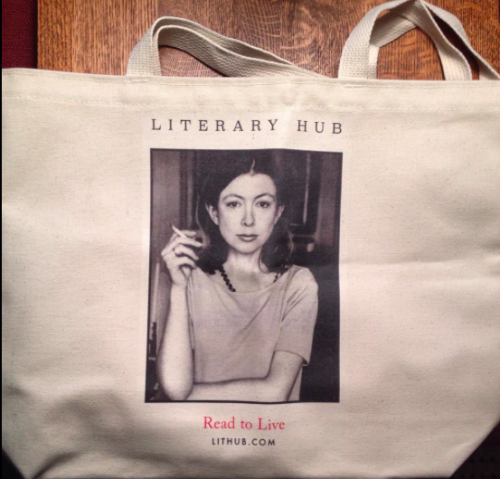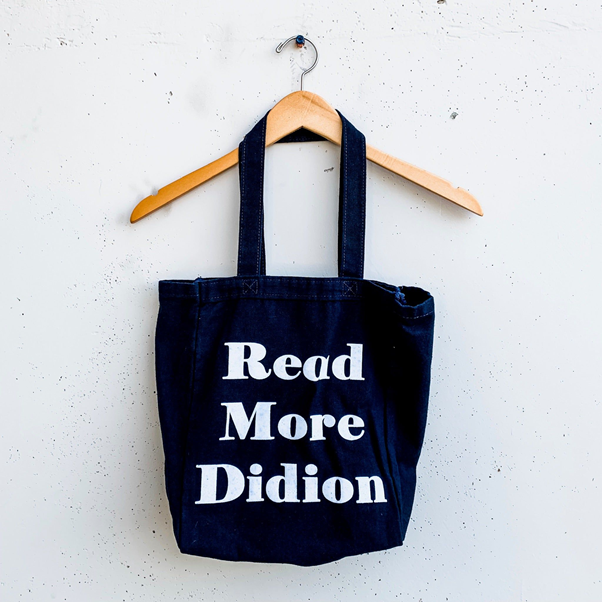Joan Didion and the case against hippies
In 1967 Joan Didion went to San Francisco to cover the hippy scene in Haight Ashbury. After spending weeks hanging out with the hippies and flower people, she didn’t feel she ‘had’ the story, but she filed it anyway, and the essay became a classic of New Journalism and a famous takedown of vacuous spirituality, called ‘Slouching Towards Bethlehem’.
I read it this month, because I’m in California and Didion is a famous Californian writer, and because I also have been writing takedowns of vacuous hippy spirituality. And because Didion just seems cool, doesn’t she, with her good looks, elegant clothing, withering expression, and customary cigarette held by arms and fingers as thin as the cigarette. She has bags of literary chic. Literally, bags of it.
Declare your cultural superiority with a Joan Didion tote bag
Didion is a good stylist. The emotional tone of her writing is cool, frosty even. There is an emotional flatness in her writing, which cracks into the occasional fissure of despair. It reminds me of Brett Easton Ellis writing about hip LA youth numbing themselves with drugs (he’s said Didion is ‘the writer who means most to me’.). And that cold, flat tone works well as a juxtaposition against her subjects’ vapid mysticism, as in this typical vignette:
Four boys and one middle-aged man are sitting on a grass mat at Sandy’s place, sipping anise tea and watching Sandy read Laura Huxley’s You Are Not the Target.
We sit down and have some anise tea. ‘Meditation turns us on’, Sandy says. He has a shaved head and the kid of cherubic face usually seen in newspaper reports of mass murderers. The middle-aged man, whose name is George, is making me uneasy because he is in a trance next to me and stares at me without seeing me.
I feel that my mind is going — George is dead, or we all are — when the telephone rings.
‘It’s for George’, Sandy says.
‘George, telephone.’
‘George.’
Somebody waves his hand in front of George and George finally gets up, bows, and moves towards the door on the balls of his feet.
‘I think I’ll take George’s tea’, somebody says. ‘George — are you coming back?’
George stops at the door and stares at each of us in turn. ‘In a moment’, he snaps.
The entire essay is a jumble of these sort of flash cuts, snatches of far-out dialogue, as if she simply gathered together the scraps of her notes and filed them. Like Hunter S. Thompson or Geoff Dyer, Didion made a triumph of her failure to ‘get the story’.
But whereas for Thompson or Dyer, this failure is because their personality and hedonism get in the way of their assignment, with Didion, the failure is not hers but her subject’s. She can’t connect the fragments into a coherent story because the hippy scene itself is incoherent, lacking a centre.
‘The centre was not holding’, she begins the essay, referencing here and in its title WB Yeats’ poem ‘The Second Coming’. Like Yeats — an authoritarian despiser of mass culture — Didion suggests that order, tradition, meaning and language itself is dissolving in acid. All that remains, as in TS Eliot’s Wasteland, are fragments.
For such a hip writer, beloved of the liberal literary elite, it’s a surprise to discover that Didion is basically, like Eliot and Yeats, a right-wing traditionalist. America is going to the dogs, she says, because the youth are dropping out and taking drugs.
She writes, in the essay’s sombre opening:
The centre was not holding. It was a country of bankruptcy notices and public-auction announcements and commonplace reports of casual killings and misplaced children and abandoned homes and vandals who misspelled even the four-letter words they scrawled. It was a country in which families routinely disappeared, trailing bad checks and repossession papers. Adolescents drifted from city to torn city, sloughing off both the past and the future as snakes shed their skin, children who were never taught and would never now learn the games that held the society together. People were missing. Children were missing. Parents were missing….
It was not a country in open revolution. It was not a country under enemy siege. It was the United States of America in the cold late spring of 1967, and the market was steady and the GNP high and a great many articulate people seemed to have a sense of high social purpose and it might have been a spring of brave hopes and national promise, but it was not, and more and more people had the uneasy apprehension that it was not. All that seemed clear was that at some point we had aborted ourselves and butchered the job, and because nothing else seemed so relevant I decided to go to San Francisco. San Francisco was where the social hemorhaging was showing up. San Francisco was where the missing children were gathering and calling themselves ‘hippies’. When I first went to San Francisco in that cold late spring of 1967 I did not even know what I wanted to find out, and so I just stayed around awhile and made a few friends.
She makes mordant fun of her new friends’ inarticulacy:
I am just driving down the Street and I see Barbara at a light.
What am I doing, she wants to know.
I am just driving around.
‘Groovy’, she says.
It is a beautiful day, I say.
‘Groovy’, she agrees.
She wants to know if I will come over. Sometime soon, I say.
‘Groovy’, she says.
She also wonders at the hippies’ constant, relentless drug-taking — marijuana, LSD, STP, cocaine, ketamine, dried banana, whatever, all dressed up as spirituality:
‘Once you drop acid with somebody you flash on, you see the whole world melt in her eyes’, says Max.
‘It’s stronger than anything in the world’, Sharon says.
‘Nothing can break it up’, says Max. ‘As long as it lasts.’
Her own doors of perception seem to have remained firmly closed, so we get wry trip reports like:
At three-thirty that afternoon Max, Tom and Sharon placed tabs under their tongues and sat down together in the living room to wait for the flash. Barbara stayed in the bedroom, smoking has. During the next four hours a window banged in Barbara’s room, and about five-thirty some children had a fight in the street. A curtain billowed in the afternoon wind. A cat scratched a beagle in Sharon’s lap. Except for the sitar music on the stereo there was no other sound or movement until seven thirty, when Max said ‘Wow.’
Beyond this inanity, hippy San Francisco has a darker side, in the hordes of runaway kids who apparently gathered there in search of the Age of Love. At best they come adrift and become deracinated and deculturated. Didion meets two runaways in Golden Gate Park:
I ask why they ran away.
‘My parents said I had to go to church’, Debbie says. ‘And they wouldn’t let me dress the way I wanted.’
‘Your mother was kind of a bummer’, Jeff agrees.
At worst, they become easy prey for the gang-bangers and perverts who haunt the scene. ‘Rape is as common as bullshit in Haight’, one local writer noted. Didion clocks the hippy rock stars’ taste for young girls: ‘There are always little girls around rock groups.’
Even the infants are on drugs:
The five-year-old’s name is Susan, and she tells me she is in High Kindergarten. For a year now her mother has given her both acid and peyote. I start to ask if any other children in High Kindergarten got stoned, but I falter at the key words.
The hippy movement, then, is a cultural and moral abortion in Didion’s view, the moral hemorrhaging must be staunched, the drugs banned and the kids sent home to prepare for respectable careers. America needs a return to order, or it will die. Which is exactly what President Nixon promised when he was elected in 1969, in a campaign urging a crackdown on hippy chaos (Didion thought he was too liberal).
‘The weirdest thing about it,’ Maria Bustillos wrote in Popula, ‘is this dyed-in-the-wool conservative woman…somehow became the irreproachable darling of New York media and stayed that way for decades, all on the strength of a dry, self-regarding prose style and a ‘glamor shot’ with a Corvette.’
You wouldn’t see literary cafe types toting around bags with Jordan Peterson’s face on it. But Didion’s message (at least in this essay) is the same Call to Order. In fact, she’s more right-wing — Peterson actually sees a value in psychedelics.
Now personally, I like a bit of pessimistic conservatism every now and then — it’s why I like Cormac MacCarthy’s apocalyptic novels. I enjoy the occasional polemic from a crusty right-wing conservative, especially as I get older. I like Didion’s sardonic style, her cool observations, her ear for the idiotic hippy idiom.
But four things strike me.
Firstly, can you really write about hippy spirituality entirely from the outside? This was, after all, a culture devoted to inner journeying — ‘the biggest introspective binge in history’ as Theodore Roszak put it. Tom Wolfe managed to enter in the mind-set of the Merry Pranksters in his Electric Kool-Aid Acid Test. He didn’t use drugs, he used his imagination.
Instead, in the words of The Nation, Didion’s essays ‘show a writer who attempts a close reading of the strange circumstances she encounters but then, when understanding proves difficult, draws back to look at them from a great, flat distance’.
Second, was there nothing positive about hippy culture? Nothing at all? A more balanced and sympathetic account can be found in Roszak’s Notes on the Counterculture, also published in 1968, which saw the stupidity and drug-dependency of hippy culture, but also the importance of what it was reaching for: a more direct and mystical form of religion after centuries of rationalism and bureacratisation. Hippies were, in fact, also searching for a return to order and tradition — the lost traditions of the ‘perennial philosophy’.
Third, was American culture really dying? Was hippy culture really to blame? In an acute profile of Didion, the New Yorker notes:
The sensationalized press coverage of the period has left a permanent image of the late nineteen-sixties as a time when everyone was tripping or stoned. In 1967, when Didion’s article came out, only one per cent of college students reported having tried LSD. In 1969, only four per cent of adults said they had smoked marijuana. Recreational drug use soared in the nineteen-seventies, but the press was no longer interested. The whole thing had stopped being sexy.
Despite this, President Nixon rode the wave of a moral panic into the White House, where he banned psychedelics even for research purposes, thereby freezing investigation of their therapeutic potential until four decades later. Didion’s essay contributed to that moral panic.
But the thing that really struck me about the essay was she went to San Francisco, ‘made some friends’, took advantage of their hospitality, and then mercilessly tore them apart. She sat with them for hours, smiling and taking notes of their idiocy (assuming all the quotes are genuine).
Who is really being immoral and selfish here — the dumb hippies who show kindness to a stranger, or the stranger who skewers them for the amusement and outrage of the elite? ‘Writers’, she notes in her preface, ‘are always selling somebody out.’
Her essays read, in Maria Bustillos’ words, like ‘an unrelenting exercise in class superiority’. She comes across like a frosty Manhattan socialite appalled by the vulgarity of her California relatives. Maybe that’s why the New Yorker loved her — she confirmed the East Coast in its derision of the West.
My main takeaway is: never invite Joan Didion to sit in on a trip. In the limpid prose of Jeff the runaway, she sounds like ‘kind of a bummer’.






